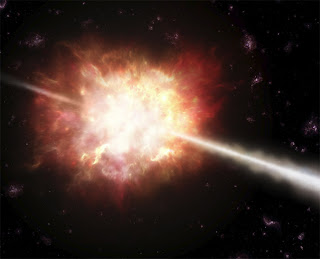No Doomsday Supernova in 2012, Says NASA Really? There are people out there who predict -- with an unbelievable degree of accuracy -- that December 2012 will herald a rare stellar explosion that will wipe out (or at least cripple) life on Earth?
Well, if my email inbox is anything to go by, then yes, I'm sure this little doomsday scenario is doing the rounds. And by the sound of things, NASA is also getting fed up with messages from individuals needlessly worrying about a star that's about to go "BOOM!"
In an impromptu public space service announcement from the U.S. space agency on Friday, Francis Reddy, of NASA's Goddard Spaceflight Center, went on the record to say: "...astronomers can say with certainty that there is no threatening star close enough to hurt Earth."
As if the world didn't have enough doomsday scenarios to worry about -- like nonsensical killer solar flares, non-existent Planet X's, silly geomagnetic reversals, insane pole shifts and hordes of kamikaze lemmings* -- doomsayers are apparently circulating the myth that a star is soon to go gangbusters this time next year. Wow.
invisible soldier
But before you rush to Barnes & Noble to buy the next crappy "Doomsday in 2012" book and put your house up for sale, take a hint: You are being conned!
"Astronomers estimate that, on average, about one or two supernovae explode each century in our galaxy," says Reddy. "But for Earth's ozone layer to experience damage from a supernova, the blast must occur less than 50 light-years away."
Guess what? The nearest star likely to go supernova any time soon is much further than 50 light-years away. Also, the galaxy is a very big place, so the odds of any stellar dramatics even remotely close to the solar system in the next 12 months is vanishingly small.
ANALYSIS: DON'T PANIC! Betelgeuse Won't Explode in 2012
Reddy goes into some of the details as to how a supernova could cause damage to the Earth's atmosphere and the life therein -- because, let's face it, a star's core collapse would be bad news if it were in our cosmic backyard -- but as there's no dying stars around, why be concerned?
But here's the kicker. What about a gamma-ray burst, the supernova's big bad cousin?
As a massive star runs out of fuel and collapses, sometimes it may form a black hole. These massive dying stars are called Wolf-Rayet (WR) stars, my favorite stellar objects. If the conditions are right, it is thought that as a WR star collapses and stellar material starts to fall into the newborn singularity, powerful jets of radiation will blast from the exploding star's poles.
Should Earth be in the line-of-sight of one of these bad boys then, well, bad news for us.
Probably the most scary thing about GRBs is their range. Should Earth be caught in the cross-hairs of a GRB, its radiation would hurt us even if the star was 10,000 light-years distant.
ANALYSIS: Will Earth 'Be Wiped Out' by a Supernova?
Fortunately, these kinds of local events happen approximately every 15 million years or so, and the nearest gamma-ray burst on record occurred a rather remote 1.3 billion light-years away.
So where are the doomsayers getting their information from if the science (and statistics) is telling us that a nearby supernova or GRB isn't expected any time soon?
Well, in the effort to build the fear-factor for the impending end of the Mayan "Long Count" calendar (plus an unhealthy dose of superstition and conspiracy), 2012ers are busy trying to sell their personal versions of doom.
Oddly enough, most doomsayers have a book to sell or website to advertise, so I won't be getting my doomsday "science" from those wingnuts.
*My own fabricated doomsday event. Everyone else is inventing end-of-the-world scenarios, so why can't I?
Image: An artist's impression of a gamma-ray burst (Credit: ESO/A. Roquette)


0 komentar:
Posting Komentar